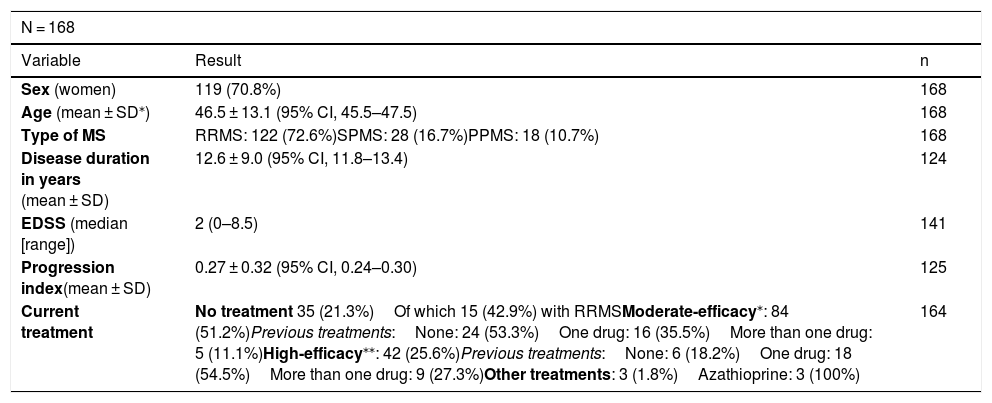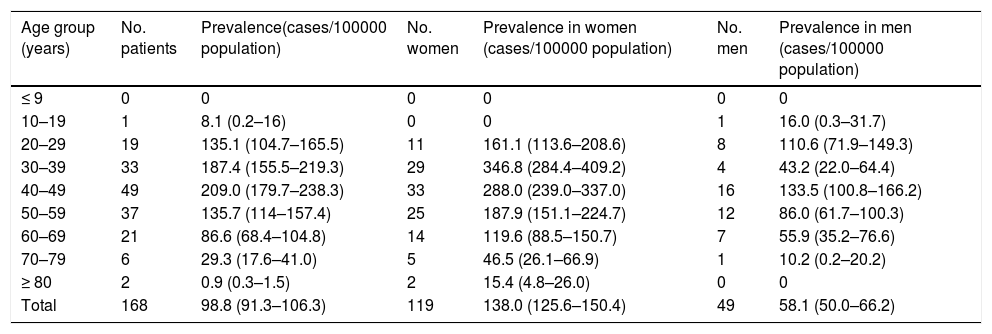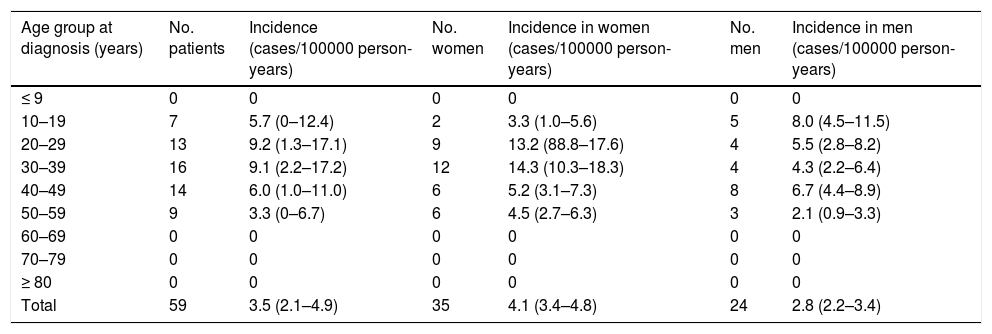We conducted a prevalence study of multiple sclerosis (MS) in the Spanish province of Zamora.
MethodsWe conducted a retrospective cohort study of data on patients with multiple sclerosis under follow-up at the neurology outpatient clinic at Hospital de Zamora as of 6 June 2021. We studied demographic (sex, age) and clinical variables (form of disease, duration, expanded disability status scale [EDSS] score, progression index [EDSS/years duration], and treatment).
ResultsAs of 6 June 2021, the prevalence of MS was 98.8 cases/100000 population (95% confidence interval [CI], 91.3–106.3), and the mean incidence for the last 10 years was 3.5 cases/100000 person-years (95% CI, 2.1–4.9). The age-standardised prevalence (calculated using the 2013 European Standard Population) was 102.4 (95% CI, 83.5–121.3), and incidence was 4.6 (95% CI, 0.5–8.7).
Out of the 168 patients in our cohort, 119 (70.8%) were women. The mean age (standard deviation) in our sample was 46.5 (13.1) (95% CI, 45.5–47.5) years, and the mean disease duration was 12.6 (9.0) (95% CI, 11.8–13.4) years, with a median EDSS score of 2.0 (range, 0–8.5). A total of 129 (78.7%) patients were receiving treatment, of which 84 (51.2%) were receiving a moderate-efficacy drug and 42 (25.6%) were receiving a high-efficacy drug. Among patients not receiving treatment, this was mostly due to their personal decision, long disease duration, and/or clinical stability.
ConclusionsThe prevalence of multiple sclerosis in the Spanish province of Zamora is intermediate-high and is in line with the mean for Spain.
Nuestro objetivo es realizar un estudio de prevalencia de esclerosis múltiple diagnosticada en la provincia de Zamora.
MétodoRealizamos un estudio de cohortes retrospectivo extrayendo los casos de esclerosis múltiple en seguimiento en el servicio de Neurología del Hospital de Zamora a fecha de 6 de junio de 2021. Estudiamos variables basales (sexo, edad) y clínicas (forma de la enfermedad, duración de la enfermedad, EDSS [expanded disability status scale], índice de progresión [EDSS / años duración] y tratamiento).
ResultadosLa prevalencia de EM el 6 de junio de 2021 fue de 98,8 casos/100000 (IC 95%: 91,3-106,3), con una incidencia media para los últimos 10 años de 3,5 casos/100000/año (IC 95%: 2,1-4,9). La prevalencia estandarizada por edad (utilizando la Población Europea Estándar de 2013) fue de 102,4 (IC 95%: 83,5-121,3), y la incidencia fue 4,6 (IC 95%: 0,5-8,7).
Dentro de los 168 pacientes con EM de nuestra cohorte, 119 (70,8%) eran mujeres, con una media de edad de 46,5 ± 13,1 (IC 95%: 45,5-47,5) años, y una media de 12,6 ± 9,0 (IC 95%: 11,8-13,4) años de duración de la enfermedad, con una mediana de EDSS de 2.0 [0–8.5]. 129 (78,7%) pacientes recibían tratamiento, de los cuales 84 (51,2%) recibían un fármaco de moderada eficacia y 42 (25,6%) recibían un fármaco de alta eficacia. La mayoría de los pacientes que no recibían tratamiento lo hacían por decisión propia, larga duración de la enfermedad, y/o estabilidad de esta.
ConclusionesLa prevalencia de esclerosis múltiple en la provincia de Zamora es media-alta y se encuentra en el promedio para España.
Multiple sclerosis (MS) is a chronic inflammatory disease of the central nervous system (CNS) that causes demyelination and neurodegeneration. MS is the first leading cause of non-traumatic disability in young adults and predominantly affects women, with a female:male ratio of 3:1.
Early treatment with immunomodulatory drugs is effective, and numerous disease-modifying drugs have been developed over the last decades. This, together with the development of diagnostic techniques (high-field MRI, specific cerebrospinal fluid studies), has contributed to the evolution of diagnostic criteria, leading to diagnóstico at increasingly earlier stages.1
The cause of MS is unclear, but the disease is known to affect individuals who present a genetic predisposition and are exposed to different environmental risk factors.2 Genetic predisposition largely depends on allelic variation in the major histocompatibility complex class II gene, sharing many susceptibility mutations with such other autoimmune diseases as type 1 narcolepsy or systemic lupus erythematosus.3 Environmental risk factors include exposure to the Epstein Barr virus, smoking, low vitamin D levels, and overweight during adolescence.2
In recent years, an increase in the incidence of MS has been observed worldwide, although this is believed to be partially due to earlier diagnóstico. MS is estimated to affect approximately 2.8 million people worldwide.4 Spain is considered to present an intermediate-high prevalence of MS, with an estimated 80–100 cases per 100,000 population.5
The most recent data on MS prevalence in Castile-Leon were published in 1999 (Zamora) and 1998 (Valladolid), with rates of 44 and 58 cases per 100,000 population, respectively.6,7 This study provides updated figures on MS prevalence in the province of Zamora.
MethodsThe region studied was the province of Zamora, located in the north-west of Spain and comprising an area of 10,561 km2 in the northernmost area of the central meseta. This province is severely affected by rural flight, which leads to specific demographic characteristics including depopulation (population density of 18.6 people/km2) and population ageing (mean age of 50.7 years). As of January 2021, the number of registered inhabitants was 170,588, with 86,219 being women (50.5% of the total population).8 There is only one public hospital in the province with a neurology department, which attends practically all patients with MS in the area (excluding those patients with private health insurance, who are a minority).
We performed a retrospective study by collecting data for patients diagnosed with MS who were under follow-up by the neurology department at Hospital de Zamora as of 6 June 2021.
We followed the usual protocols on the patients' publication, and we respected the privacy of the subjects, treating them anonymously.
We analysed demographic (sex, age) and clinical variables: form of MS, disease duration, Expanded Disability Status Scale (EDSS) score, progression index (EDSS/duration in years), and treatment. Regarding treatment, we studied the use of moderate-efficacy drugs (interferon-β, glatiramer acetate, teriflunomide, and dimethyl fumarate) and high-efficacy drugs (cladribine, fingolimod, natalizumab, ocrelizumab, and alemtuzumab), and the number of drugs used in each patient.
Age-standardised prevalence and incidence figures were calculated using the 2013 European Standard Population (ESP2013), published by Eurostat.9
tPrevalence was estimated at 6 June 2021. To retrospectively calculate the incidence rate, we used the year-on-year average of new diagnóstico of MS for the last 10 years.
ResultsOn 6 June 2021, 168 patients with a diagnóstico of MS were under follow-up in the province of Zamora. Patients' demographic and clinical characteristics are summarised in Table 1.
Patient clinical and demographic characteristics.
| N = 168 | ||
|---|---|---|
| Variable | Result | n |
| Sex (women) | 119 (70.8%) | 168 |
| Age (mean ± SD⁎) | 46.5 ± 13.1 (95% CI, 45.5–47.5) | 168 |
| Type of MS | RRMS: 122 (72.6%)SPMS: 28 (16.7%)PPMS: 18 (10.7%) | 168 |
| Disease duration in years (mean ± SD) | 12.6 ± 9.0 (95% CI, 11.8–13.4) | 124 |
| EDSS (median [range]) | 2 (0–8.5) | 141 |
| Progression index(mean ± SD) | 0.27 ± 0.32 (95% CI, 0.24–0.30) | 125 |
| Current treatment | No treatment 35 (21.3%)Of which 15 (42.9%) with RRMSModerate-efficacy⁎: 84 (51.2%)Previous treatments:None: 24 (53.3%)One drug: 16 (35.5%)More than one drug: 5 (11.1%)High-efficacy⁎⁎: 42 (25.6%)Previous treatments:None: 6 (18.2%)One drug: 18 (54.5%)More than one drug: 9 (27.3%)Other treatments: 3 (1.8%)Azathioprine: 3 (100%) | 164 |
EDSS: Expanded Disability Status Scale; PPMS: primary-progressive multiple sclerosis; RRMS: relapsing–remitting multiple sclerosis; SD: standard deviation; SPMS: secondary-progressive multiple sclerosis.
Sex- and age-adjusted prevalence.
| Age group (years) | No. patients | Prevalence(cases/100000 population) | No. women | Prevalence in women (cases/100000 population) | No. men | Prevalence in men (cases/100000 population) |
|---|---|---|---|---|---|---|
| ≤ 9 | 0 | 0 | 0 | 0 | 0 | 0 |
| 10–19 | 1 | 8.1 (0.2–16) | 0 | 0 | 1 | 16.0 (0.3–31.7) |
| 20–29 | 19 | 135.1 (104.7–165.5) | 11 | 161.1 (113.6–208.6) | 8 | 110.6 (71.9–149.3) |
| 30–39 | 33 | 187.4 (155.5–219.3) | 29 | 346.8 (284.4–409.2) | 4 | 43.2 (22.0–64.4) |
| 40–49 | 49 | 209.0 (179.7–238.3) | 33 | 288.0 (239.0–337.0) | 16 | 133.5 (100.8–166.2) |
| 50–59 | 37 | 135.7 (114–157.4) | 25 | 187.9 (151.1–224.7) | 12 | 86.0 (61.7–100.3) |
| 60–69 | 21 | 86.6 (68.4–104.8) | 14 | 119.6 (88.5–150.7) | 7 | 55.9 (35.2–76.6) |
| 70–79 | 6 | 29.3 (17.6–41.0) | 5 | 46.5 (26.1–66.9) | 1 | 10.2 (0.2–20.2) |
| ≥ 80 | 2 | 0.9 (0.3–1.5) | 2 | 15.4 (4.8–26.0) | 0 | 0 |
| Total | 168 | 98.8 (91.3–106.3) | 119 | 138.0 (125.6–150.4) | 49 | 58.1 (50.0–66.2) |
Sex- and age-adjusted prevalence data are included in Table 2.
The number of patients is expressed as absolute frequencies. Prevalence was calculated for each sex and age group using official data for the province of Zamora from the Spanish National Statistics Institute.8 Prevalence is expressed as cases per 100,000 population, with the 95% confidence interval.
Our sample included 119 women (70.8%), with a mean (SD) age of 46.5 (13.1) years (95% CI, 45.5–47.5), mean disease duration of 12.6 (9.0) years (95% CI, 11.8–13.4), median EDSS score of 2 (range, 0–85), and a mean disease progression index (year-on-year increase in EDSS score) of 0.27 (0.32) (95% CI, 0.24–0.30) points. Fig. 1 shows the distribution of disability according to EDSS score in our cohort.
Sex- and age-adjusted incidence in the past 10 years (2011–2020).
| Age group at diagnosis (years) | No. patients | Incidence (cases/100000 person-years) | No. women | Incidence in women (cases/100000 person-years) | No. men | Incidence in men (cases/100000 person-years) |
|---|---|---|---|---|---|---|
| ≤ 9 | 0 | 0 | 0 | 0 | 0 | 0 |
| 10–19 | 7 | 5.7 (0–12.4) | 2 | 3.3 (1.0–5.6) | 5 | 8.0 (4.5–11.5) |
| 20–29 | 13 | 9.2 (1.3–17.1) | 9 | 13.2 (88.8–17.6) | 4 | 5.5 (2.8–8.2) |
| 30–39 | 16 | 9.1 (2.2–17.2) | 12 | 14.3 (10.3–18.3) | 4 | 4.3 (2.2–6.4) |
| 40–49 | 14 | 6.0 (1.0–11.0) | 6 | 5.2 (3.1–7.3) | 8 | 6.7 (4.4–8.9) |
| 50–59 | 9 | 3.3 (0–6.7) | 6 | 4.5 (2.7–6.3) | 3 | 2.1 (0.9–3.3) |
| 60–69 | 0 | 0 | 0 | 0 | 0 | 0 |
| 70–79 | 0 | 0 | 0 | 0 | 0 | 0 |
| ≥ 80 | 0 | 0 | 0 | 0 | 0 | 0 |
| Total | 59 | 3.5 (2.1–4.9) | 35 | 4.1 (3.4–4.8) | 24 | 2.8 (2.2–3.4) |
Sex- and age-adjusted incidence data are included in Table 3.
The number of patients is expressed as absolute frequencies. Incidence was calculated for each sex and age group using the official data for the province of Zamora from the Spanish National Statistics Institute.8 Incidence is expressed as cases per 100,000 person-years, with the 95% confidence interval.
Number of patients in the cohort in each section of the EDSS score [10].
In our sample, 129 patients (78.8%) were receiving some disease-modifying drug: moderate-efficacy drugs (interferon-β, glatiramer acetate, teriflunomide, or dimethyl fumarate) in 84 cases (51.2%), and high-efficacy drugs (fingolimod, cladribine, natalizumab, ocrelizumab, or alemtuzumab) in 42 (25.6%). Treatment-naive patients accounted for 53.3% of patients receiving moderate-efficacy drugs and 18.2% of those receiving high-efficacy drugs. All patients receiving a moderate-efficacy drug who were not treatment-naive switched treatment within the same therapeutic line. Of the patients not receiving treatment at the time of the study, this was due to personal decision, long disease duration, and/or disease stability in most cases.
According to these data, the prevalence of MS in the province of Zamora is 9.8 cases/100000 population (95% CI, 91.3–106.3), with a mean incidence for the past 10 years of 3.5 cases/100000 person-years (95% CI, 2.1–4.9) The age-standardised prevalence rate (using the ESP2013) amounted to 102.4 (95% CI, 83.5–121.3), and incidence was 4.6 (95% CI, 0.5–8.7).
ConclusionsThe prevalence of MS in the province of Zamora is in line with the mean for the Spanish population, but moderate-high with respect to worldwide figs.5
We retrospectively identified one limitation in our incidence study: some incident cases may very likely have been lost, which would be unsurprising as the population of the province has decreased from 193,383 in 2011 to 170,588 in 2021,8 a 11.8% reduction in population over 10 years, due to both population ageing and migratory flow.
In line with the global trend, current prevalence is significantly higher than the most recent figures available for the province (from 1999), with an estimated prevalence of 44 cases per 100,000 population, and incidence of 2.8 cases per 100,000 person-years.6
The main limitations of our study are due to its retrospective design. However, our results are consistent with those obtained in similar studies, showing an upward trend in MS prevalence worldwide and in Spain. Further prospective studies are needed to more comprehensively analyse the causes.









![Number of patients in the cohort in each section of the EDSS score [10]. Number of patients in the cohort in each section of the EDSS score [10].](https://static.elsevier.es/multimedia/26670496/0000000200000001/v1_202202050526/S2667049621000880/v1_202202050526/en/main.assets/thumbnail/gr1.jpeg?xkr=ue/ImdikoIMrsJoerZ+w96p5LBcBpyJTqfwgorxm+Ow=)
